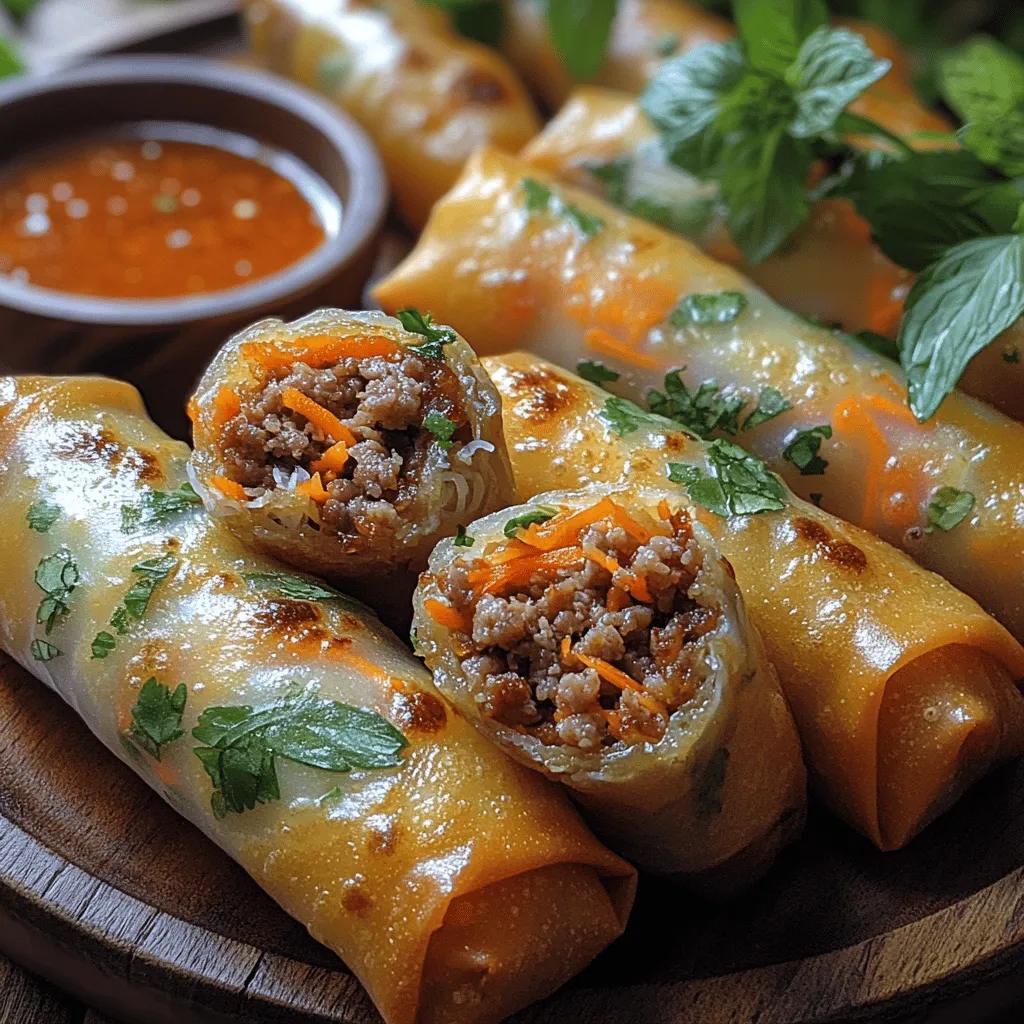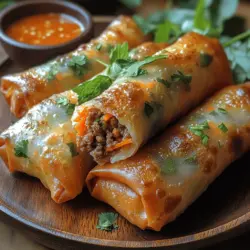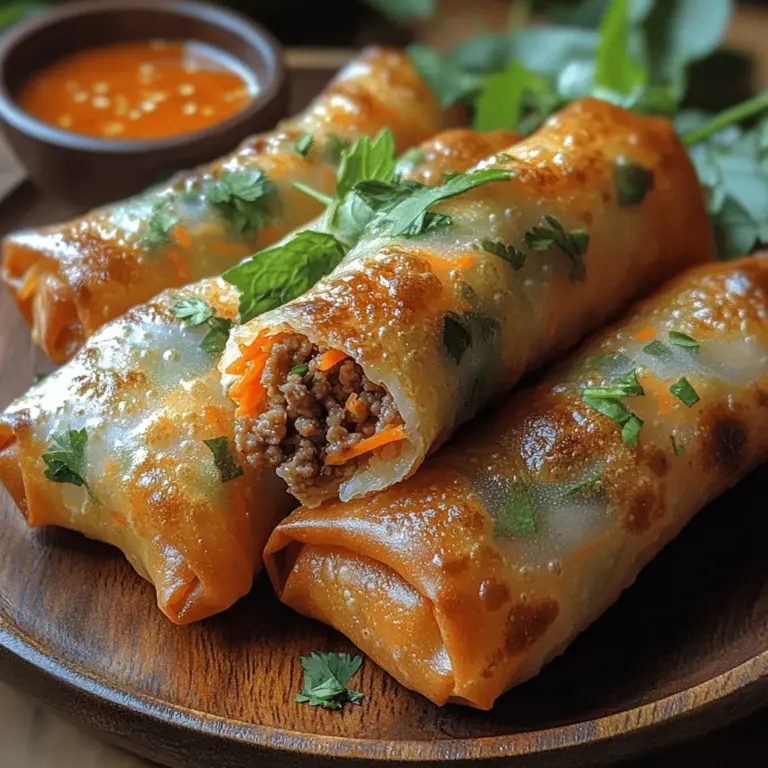Introduction
Crispy Vietnamese spring rolls, often known as “goi cuon,” are a beloved dish that encapsulates the vibrant flavors and textures of Vietnamese cuisine. With their crunchy exterior, fresh fillings, and a variety of dipping sauces, these spring rolls offer an exciting culinary experience that appeals to both novice cooks and experienced chefs. As modern cooking trends increasingly emphasize the importance of homemade meals, crafting your own spring rolls not only allows for customization in terms of ingredients but also fosters a deeper connection with the food you prepare.
In this article, we will delve into the art of making these delightful spring rolls, exploring their origins, discussing the essential ingredients that contribute to their unique taste, and outlining the preparation process step-by-step. You’ll learn about the necessary tools, cooking techniques, and flavor enhancements that will elevate your homemade spring rolls to a new level of deliciousness.
Understanding the Recipe
Description and Origins
Crispy Vietnamese spring rolls are traditional appetizers that have made their way into the hearts of food lovers around the world. Originating from Vietnam, these rolls are typically filled with a mix of vegetables, proteins, and sometimes noodles, all wrapped in a delicate rice paper shell. The contrast between the crunchy outer layer and the fresh, flavorful filling makes them an irresistible snack or starter.
The history of spring rolls in Vietnam can be traced back centuries, with regional variations that showcase local ingredients and culinary traditions. In addition to their delicious taste, these rolls are often enjoyed during celebrations and family gatherings, making them a staple in Vietnamese culture.
Key Ingredients and Their Roles
The beauty of crispy Vietnamese spring rolls lies in their versatility, allowing for various combinations of fillings and flavors. Here are some key ingredients commonly used in this recipe:
1. Rice Paper Wrappers: The foundation of spring rolls, these translucent sheets are made from rice flour and water. They become pliable when soaked in warm water, making them easy to wrap around your chosen fillings.
2. Proteins: Common protein options include shrimp, pork, chicken, or tofu, providing a hearty and satisfying element to the rolls.
3. Fresh Vegetables: Ingredients like lettuce, carrots, cucumber, and herbs not only add crunch but also contribute vital nutrients and freshness.
4. Noodles: Vermicelli noodles are often included for added texture and substance, making the rolls more filling.
5. Dipping Sauce: A flavorful sauce, such as hoisin or peanut sauce, complements the spring rolls and enhances their taste profile.
Health Benefits of the Ingredients
Homemade crispy Vietnamese spring rolls are not only delicious but also packed with health benefits. The use of fresh vegetables provides essential vitamins and minerals, while lean proteins contribute to muscle building and repair. Rice paper wrappers are low in calories and gluten-free, making them an excellent choice for those with dietary restrictions. Additionally, the presence of herbs such as mint and cilantro not only elevates the flavor but also offers antioxidant properties, promoting overall health.
Preparation Process
Essential Tools and Equipment
Before diving into the preparation of your crispy Vietnamese spring rolls, it’s important to gather the necessary tools and equipment to ensure a smooth cooking experience. Here’s what you’ll need:
– Large Mixing Bowl: For soaking the rice paper wrappers.
– Cutting Board and Sharp Knife: To chop vegetables and proteins efficiently.
– Large Plate or Tray: For assembling the spring rolls.
– Measuring Cups and Spoons: To accurately measure ingredients.
– Clean Kitchen Towel: For drying the soaked rice paper wrappers and preventing them from sticking.
Step-by-Step Breakdown of the Preparation Process
1. Prepare the Fillings: Start by washing and slicing your vegetables into thin strips. If you’re using proteins like shrimp or chicken, cook them thoroughly and chop them into bite-sized pieces. For vegetarian options, cube the tofu and sauté it if desired.
2. Cook the Noodles: If you’re using vermicelli noodles, cook them according to package instructions, then drain and rinse under cold water to prevent sticking.
3. Soak the Rice Paper Wrappers: Fill a large mixing bowl with warm water. Dip one rice paper wrapper into the water for about 10-15 seconds or until it becomes soft and pliable. Remove it from the water and lay it flat on a clean surface or plate.
4. Assemble the Spring Rolls: On the lower third of the rice paper wrapper, layer a small amount of each filling: a few pieces of protein, a handful of noodles, and a selection of vegetables and herbs. Be careful not to overfill, as this can make rolling difficult.
5. Roll It Up: Fold the sides of the rice paper over the filling, then roll it tightly from the bottom up, ensuring the filling is secure inside. Repeat this process for the remaining wrappers.
Tips for Effective Meal Prep and Organization
– Mise en Place: Prepare all your ingredients before starting the assembly process. This will streamline your cooking experience and ensure you have everything you need at hand.
– Keep the Wrappers Covered: As you assemble your spring rolls, keep the remaining rice paper wrappers covered with a damp kitchen towel to prevent them from drying out.
– Practice Makes Perfect: If you’re new to rolling spring rolls, don’t worry if your first few attempts don’t look perfect. With practice, you’ll become more efficient and confident in your rolling technique.
Cooking Techniques
Detailed Explanation of Cooking Methods
While the primary focus of this recipe is on assembling and rolling the spring rolls, cooking techniques come into play when you choose to fry or bake them. Here’s a breakdown of both methods:
– Frying: For those who prefer a crispy texture, deep frying is the most common method. Heat vegetable oil in a deep skillet or wok until it reaches 350°F (175°C). Carefully add the spring rolls, frying them in batches until they are golden brown and crispy, about 2-4 minutes per side. Drain them on paper towels to remove excess oil.
– Baking: For a healthier alternative, you can bake the spring rolls. Preheat your oven to 425°F (220°C). Place the assembled spring rolls on a baking sheet lined with parchment paper, and lightly brush them with oil. Bake for 15-20 minutes, turning halfway through for even cooking, until they are crisp and golden.
Importance of Temperature Control and Timing
Whether you choose to fry or bake your spring rolls, temperature control is key to achieving the perfect crunch. For frying, maintaining the right oil temperature is essential; if the oil is too cool, the rolls will absorb excess oil and become greasy. Conversely, if the oil is too hot, the exterior may burn before the filling is cooked.
For baking, keeping an eye on the time and turning the spring rolls halfway through ensures even cooking and crispiness. The goal is to achieve a golden-brown color that signifies a perfectly cooked spring roll.
Common Mistakes to Avoid During the Cooking Process
1. Overfilling: While it may be tempting to pack in as many ingredients as possible, overfilling can lead to difficulty in rolling and potential tearing of the rice paper.
2. Improper Soaking: Soaking the rice paper wrappers for too long can make them overly soft and prone to tearing. Conversely, under-soaking can make them difficult to roll. Aim for a balance to achieve the right texture.
3. Inconsistent Cooking Times: If frying, ensure that you fry in small batches to maintain oil temperature. Cooking too many spring rolls at once can lead to uneven frying.
4. Skipping the Dipping Sauce: Finally, don’t forget the importance of a good dipping sauce! The right sauce can elevate your spring rolls and enhance the overall dining experience.
By understanding the origins, ingredients, and preparation process of crispy Vietnamese spring rolls, you are well on your way to mastering this delightful dish. In the next part of this article, we will explore flavor enhancements, including spices and herbs that can elevate your spring rolls and tips on customizing the recipe to suit your personal taste preferences. Stay tuned for more delicious insights!

Serving Suggestions
When it comes to enjoying crispy Vietnamese spring rolls, the right accompaniments can elevate your dining experience. Here are some ideal pairings and creative serving ideas to consider:
1. Dipping Sauces: The classic pairing for spring rolls is a tangy dipping sauce. Consider serving with hoisin sauce mixed with peanut butter for a sweet and savory experience, or a traditional nuoc cham, which is a fish sauce-based dip sweetened with sugar and lime juice. For a spicy kick, add some chili paste or sriracha to your sauces.
2. Side Dishes: Spring rolls can be complemented by a fresh, crunchy salad. A simple cucumber and carrot salad drizzled with lime juice and sprinkled with sesame seeds adds brightness. Alternatively, a bowl of pho or a light broth can serve as a comforting side that pairs well with the crispy texture of the rolls.
3. Creative Serving Ideas: For special occasions, arrange your spring rolls on a large platter surrounded by colorful garnishes such as fresh herbs, lime wedges, and sliced chilies. This not only enhances the visual appeal but also invites guests to customize their experience with the garnishes. For a festive touch, consider creating a spring roll bar where guests can assemble their own rolls with various fillings and sauces.
4. Presentation Tips: To present your spring rolls appealingly, use a decorative serving dish or bamboo steamer basket lined with lettuce leaves. This not only looks beautiful but also keeps the rolls fresh and adds a layer of flavor. A sprinkle of sesame seeds or fresh cilantro on top can also enhance the dish’s presentation.
Nutritional Information
Understanding the nutritional value of your homemade crispy Vietnamese spring rolls can help you make informed dietary choices. Here’s a breakdown of the approximate calorie and macronutrient content per serving (two spring rolls):
– Calories: 150-200
– Protein: 5-6 grams
– Carbohydrates: 25-30 grams
– Fat: 5-7 grams
– Fiber: 2-3 grams
Dietary Considerations
These spring rolls can be easily adapted to fit various dietary needs. For example:
– Gluten-Free: Use rice paper wrappers, which are naturally gluten-free, and ensure that your dipping sauces do not contain soy sauce unless using gluten-free alternatives.
– Vegan: Replace any meat or seafood with tofu or additional vegetables like mushrooms, bell peppers, and avocado for a satisfying vegan option.
– Low-Carb: For a lower carbohydrate option, consider using lettuce leaves instead of rice paper wrappers and fill them with your favorite spring roll ingredients.
Tips for Making the Dish More Nutritious
To enhance the nutritional profile of your spring rolls, consider the following tips:
– Incorporate More Vegetables: Add a variety of colorful vegetables such as bell peppers, zucchini, or spinach to increase the vitamin and mineral content.
– Use Whole Grains: If using a grain-based filling, opt for whole grains like brown rice or quinoa for added fiber.
– Add Healthy Fats: Include avocado or a sprinkle of nuts or seeds for healthy fats that improve satiety.
Storing and Reheating
Proper storage and reheating methods can help maintain the flavor and texture of your crispy Vietnamese spring rolls.
Best Practices for Storing Leftovers
– Refrigeration: If you have leftover spring rolls, store them in an airtight container in the refrigerator for up to 3 days. Ensure they are not stacked directly on top of one another to prevent sticking.
– Wrapping: For added protection, wrap each spring roll in damp paper towels before placing them in a container. This helps to retain moisture and prevent them from drying out.
Freezing the Dish for Future Meals
– Freezing: If you want to prepare a larger batch, you can freeze uncooked spring rolls. Lay them flat on a baking sheet lined with parchment paper and freeze them for 1-2 hours until solid. Once frozen, transfer them to a freezer-safe bag or container. They can be stored in the freezer for up to 3 months.
– Cooking from Frozen: When you’re ready to cook, there’s no need to thaw. Simply fry them straight from the freezer, adding a few extra minutes to the cooking time.
Reheating Methods to Maintain Flavor and Texture
– Oven or Air Fryer: To reheat spring rolls, preheat your oven or air fryer to 375°F (190°C). Place the spring rolls on a baking sheet or in the air fryer basket and heat for about 5-10 minutes, or until they are crispy.
– Pan-Frying: Alternatively, reheat leftover spring rolls in a pan over medium heat with a little oil. Cook until heated through and crispy, ensuring they don’t burn.
Variations of the Recipe
Exploring variations of crispy Vietnamese spring rolls can introduce exciting flavors and cater to different dietary preferences.
1. Alternative Ingredients for Dietary Restrictions:
– If you have a nut allergy, replace peanuts with sunflower seeds or omit them altogether.
– For those avoiding animal products, experiment with plant-based protein sources, such as lentils or chickpeas, mixed with your choice of vegetables.
2. Regional Variations of the Dish and Their Unique Twists:
– In Southern Vietnam, spring rolls often include a mix of ground pork, shrimp, and herbs, while Northern versions may focus more on vegetables.
– Consider adding local herbs like perilla or mint for a regional touch.
3. Seasonal Adaptations to Keep the Dish Fresh and Relevant:
– In spring, use fresh asparagus, snap peas, and radishes to celebrate the season’s bounty. In the fall, sweet potatoes and roasted squash can add warmth and heartiness to your rolls.
Conclusion
Crispy Vietnamese spring rolls offer a delightful combination of textures and flavors that make them a beloved dish. With their versatility, they can be served at casual gatherings or dressed up for special occasions. This recipe not only showcases the joy of cooking but also encourages creativity in the kitchen.
Whether you opt for traditional fillings or explore new variations, the process of rolling, dipping, and sharing these spring rolls with family and friends is a rewarding experience. So gather your ingredients, roll up your sleeves, and embark on this culinary adventure. Enjoy the satisfaction of creating a dish that brings people together, and don’t hesitate to experiment with your own twists to make this recipe uniquely yours. Happy cooking!

